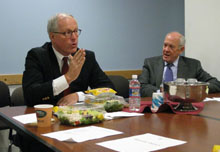Event
Johnson: The Obama transition is going ‘extremely well’

November 19, 2008 — James A. Johnson got his first taste of presidential transitions in 1976, after Jimmy Carter defeated Gerald Ford in hard-fought contest. “The day after the election, we loaded up on the campaign plane and the entire travelling press of the entire staff of the Mondale for Vice President campaign was introduced to Plains, Georgia,” Johnson said, adding, “It’s something that can be done very thoroughly in just a few minutes.” Between the election and the inauguration on January 20, 1977, Johnson said he made 13 additional trips to that small Georgia town, “and in that context saw a lot of what the transition process was all about.”
Described by Director Alex S. Jones as “a player at the very highest level of politics for a long time,” Johnson was at the Shorenstein Center to provide an inside look at the presidential transition process, both historically and in the context of the upcoming power shift. A guest of honor at Johnson’s talk was Walter Mondale, whose 1984 presidential campaign Johnson chaired. He later handled debate negotiations for Al Gore in 2000 and John Kerry in 2004, and also led Kerry’s 2004 transition planning, “which, for at least the afternoon of Election Day in Boston, was an extremely important job,” Johnson joked.
While he doesn’t have an official role with President-Elect Barack Obama’s team, Johnson’s been watching its work closely. “The transition has now of course been under way since the late spring,” he said. “It got going in earnest in the summer.” While incoming chief executives have to observe the “one president at a time” dynamic, Johnson said, “You have to show that you are focused on things that people care about and that you have understood the mandate that you have been given.”
So how is Barack Obama doing? “Extremely well,” Johnson said. “There’s a broad consensus that Republicans have something in their genes or DNA that allow them to do good transitions and there’s something we have that prevents us from doing good transitions. I think we’ve got a big change this time.”
This article was written by and the photos taken by Leighton Walter Kille of the Shorenstein Center.